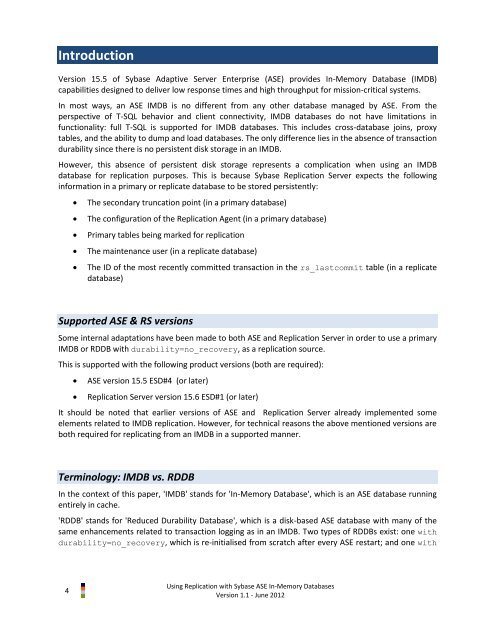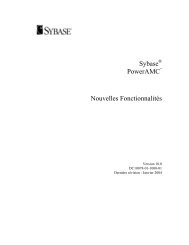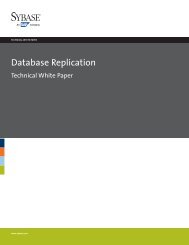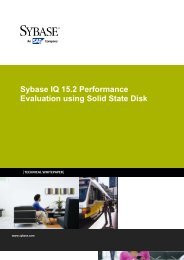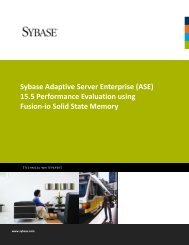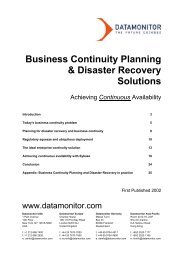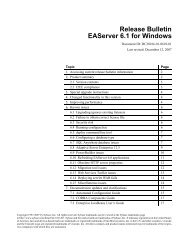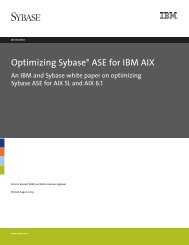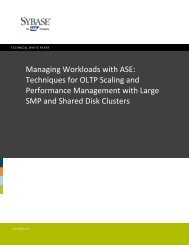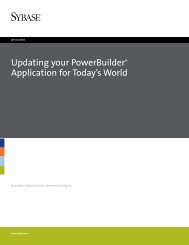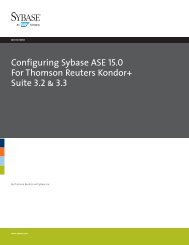IMDB Replication - Sybase
IMDB Replication - Sybase
IMDB Replication - Sybase
You also want an ePaper? Increase the reach of your titles
YUMPU automatically turns print PDFs into web optimized ePapers that Google loves.
Introduction<br />
Version 15.5 of <strong>Sybase</strong> Adaptive Server Enterprise (ASE) provides In-Memory Database (<strong>IMDB</strong>)<br />
capabilities designed to deliver low response times and high throughput for mission-critical systems.<br />
In most ways, an ASE <strong>IMDB</strong> is no different from any other database managed by ASE. From the<br />
perspective of T-SQL behavior and client connectivity, <strong>IMDB</strong> databases do not have limitations in<br />
functionality: full T-SQL is supported for <strong>IMDB</strong> databases. This includes cross-database joins, proxy<br />
tables, and the ability to dump and load databases. The only difference lies in the absence of transaction<br />
durability since there is no persistent disk storage in an <strong>IMDB</strong>.<br />
However, this absence of persistent disk storage represents a complication when using an <strong>IMDB</strong><br />
database for replication purposes. This is because <strong>Sybase</strong> <strong>Replication</strong> Server expects the following<br />
information in a primary or replicate database to be stored persistently:<br />
4<br />
The secondary truncation point (in a primary database)<br />
The configuration of the <strong>Replication</strong> Agent (in a primary database)<br />
Primary tables being marked for replication<br />
The maintenance user (in a replicate database)<br />
The ID of the most recently committed transaction in the rs_lastcommit table (in a replicate<br />
database)<br />
Supported ASE & RS versions<br />
Some internal adaptations have been made to both ASE and <strong>Replication</strong> Server in order to use a primary<br />
<strong>IMDB</strong> or RDDB with durability=no_recovery, as a replication source.<br />
This is supported with the following product versions (both are required):<br />
ASE version 15.5 ESD#4 (or later)<br />
<strong>Replication</strong> Server version 15.6 ESD#1 (or later)<br />
It should be noted that earlier versions of ASE and <strong>Replication</strong> Server already implemented some<br />
elements related to <strong>IMDB</strong> replication. However, for technical reasons the above mentioned versions are<br />
both required for replicating from an <strong>IMDB</strong> in a supported manner.<br />
Terminology: <strong>IMDB</strong> vs. RDDB<br />
In the context of this paper, '<strong>IMDB</strong>' stands for 'In-Memory Database', which is an ASE database running<br />
entirely in cache.<br />
'RDDB' stands for 'Reduced Durability Database', which is a disk-based ASE database with many of the<br />
same enhancements related to transaction logging as in an <strong>IMDB</strong>. Two types of RDDBs exist: one with<br />
durability=no_recovery, which is re-initialised from scratch after every ASE restart; and one with<br />
Using <strong>Replication</strong> with <strong>Sybase</strong> ASE In-Memory Databases<br />
Version 1.1 - June 2012


